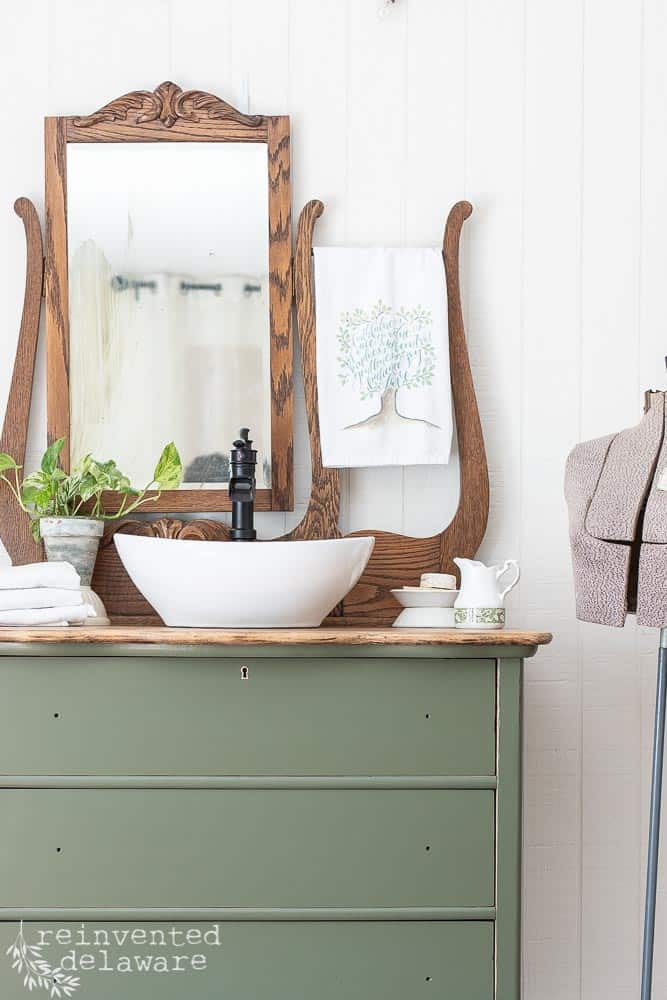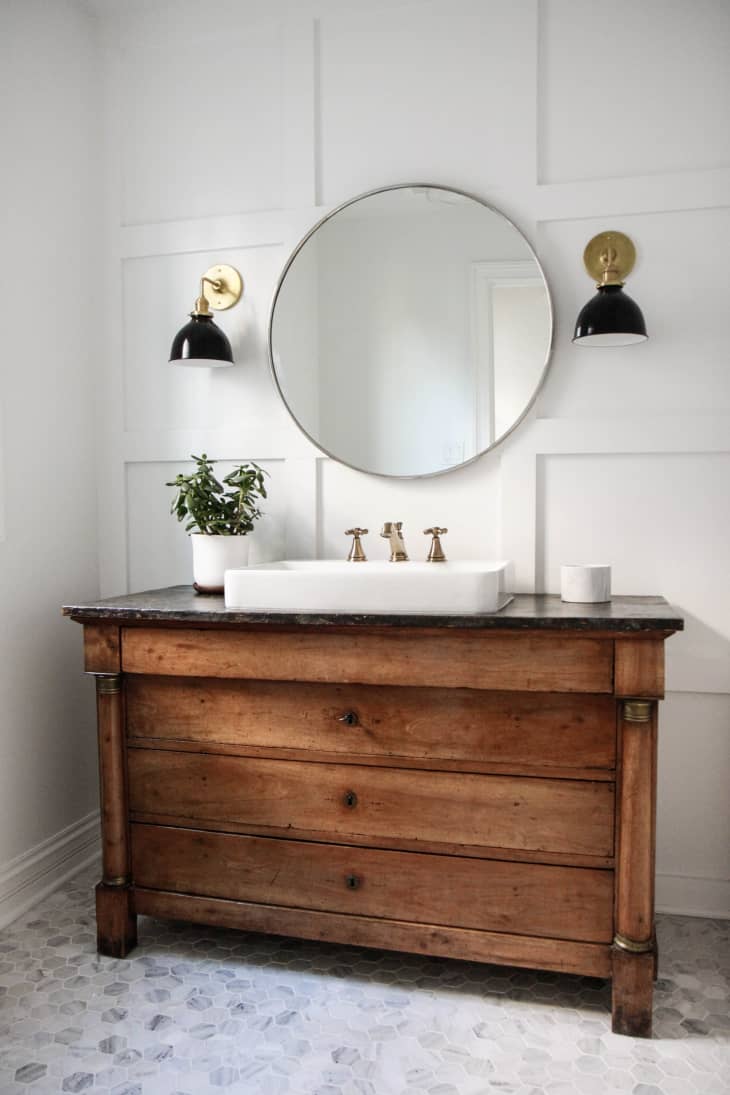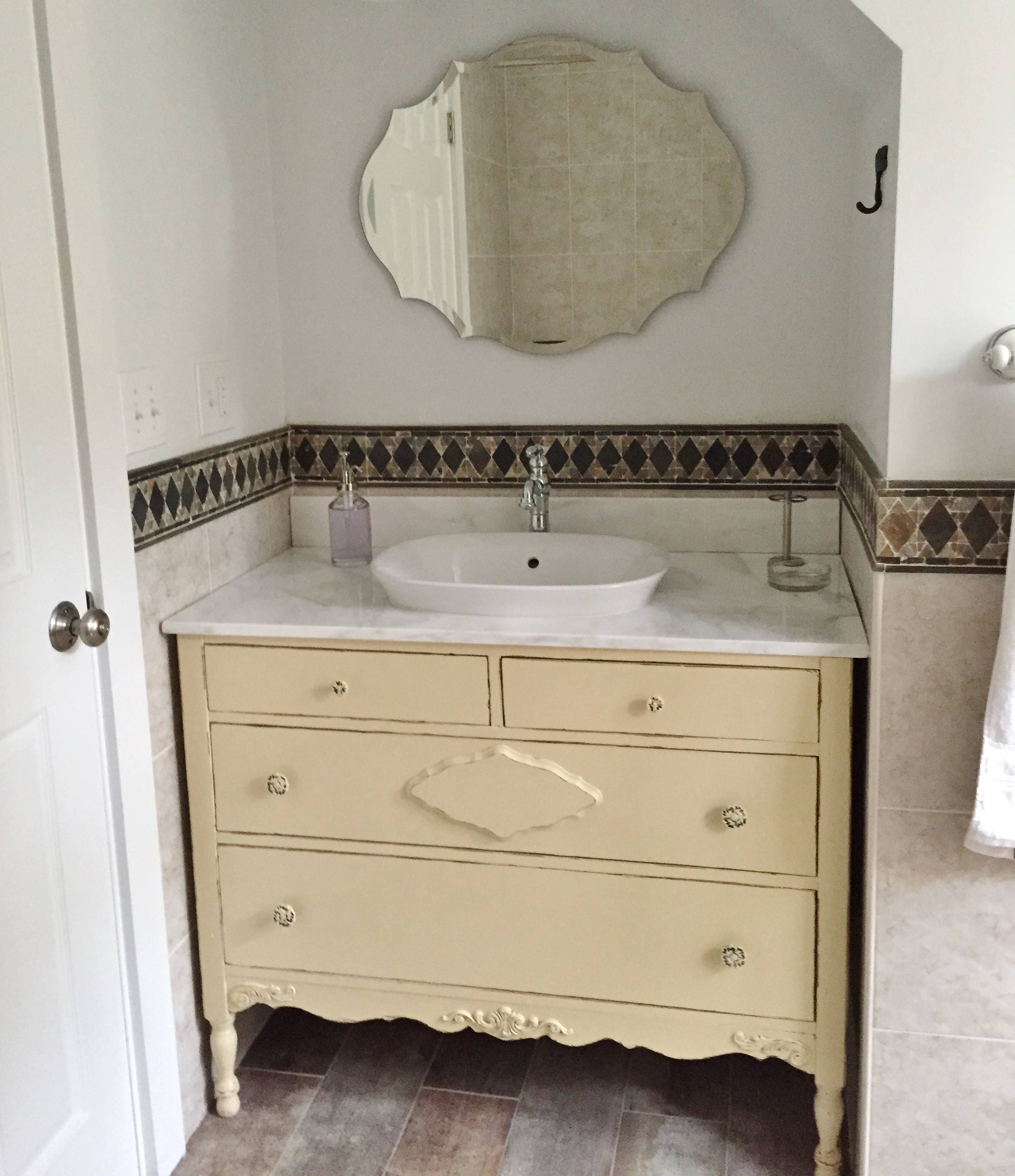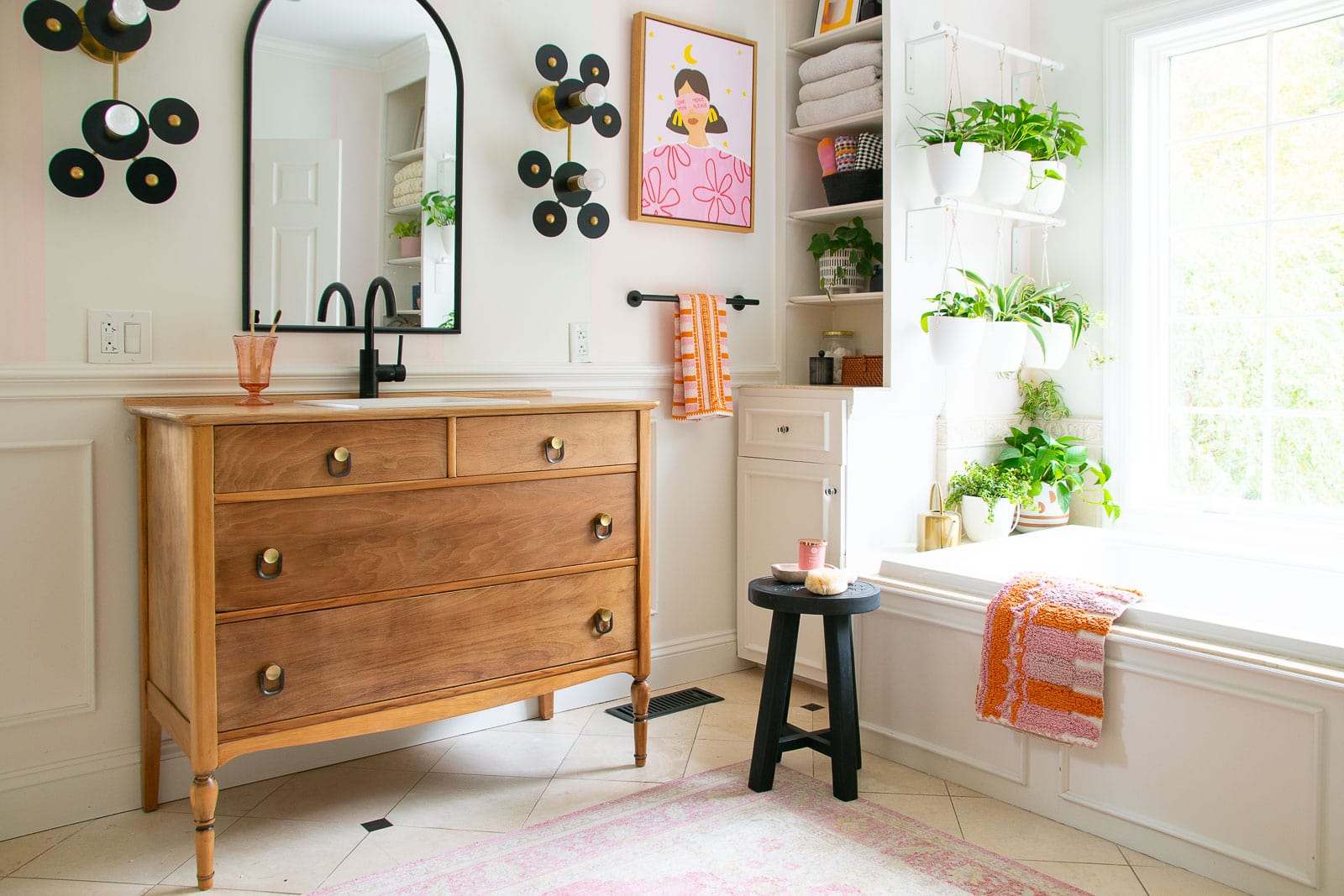Introduction to Antique Dresser Bathroom Vanities
Transforming an antique dresser into a bathroom vanity is an innovative way to merge vintage aesthetics with modern functionality. This trend has gained popularity due to its ability to create a unique, personalized look in any bathroom. Below are several key points to understand why antique dresser bathroom vanities have become a favored design choice.
- A Blend of Old and New: The appeal of an antique dresser bathroom vanity lies in its ability to seamlessly blend the old with the new. These pieces carry history and character, offering a stark contrast to the often sleek, minimalist designs of modern bathrooms. By incorporating an antique dresser, you bring warmth, charm, and a sense of nostalgia into the space, making the bathroom not just a utility area but a place of comfort and style.
- Sustainable and Eco-Friendly: Repurposing an antique dresser is a sustainable option for those looking to reduce waste. Instead of discarding an old piece of furniture, you give it a new lease on life. This eco-friendly approach aligns with the growing trend of upcycling and recycling, helping to minimize the environmental impact of home renovations. Moreover, antique dressers are typically made from high-quality materials, ensuring durability and longevity.
- Customization Opportunities: An antique dresser bathroom vanity allows for endless customization. You can choose the type of wood, the finish, and the hardware that best suits your bathroom’s aesthetic. Whether you prefer a rustic, distressed look or a polished, elegant finish, the possibilities are endless. Additionally, the vanity can be tailored to fit your specific needs, such as adding extra storage or adjusting the height.
- Cost-Effective Design Solution: While high-end bathroom vanities can be expensive, converting an antique dresser can be a more cost-effective option. Depending on where you source your dresser, you might find a beautiful piece for a fraction of the cost of a new vanity. Even with the cost of modifications and installation, the total expense can be considerably lower, allowing you to achieve a high-end look without breaking the bank.
- A Unique Focal Point: An antique dresser bathroom vanity serves as a unique focal point in your bathroom. Unlike mass-produced vanities, an antique dresser is one-of-a-kind, with its own story and character. It becomes a conversation piece, adding personality and interest to the space. The combination of antique craftsmanship with modern bathroom fixtures creates a stunning visual impact.
- Enhancing Home Value: Investing in an antique dresser bathroom vanity can also enhance the value of your home. Potential buyers often appreciate the uniqueness and quality of custom features, especially in key areas like the bathroom. A well-executed antique vanity can make your bathroom stand out, adding to the overall appeal and value of your property.
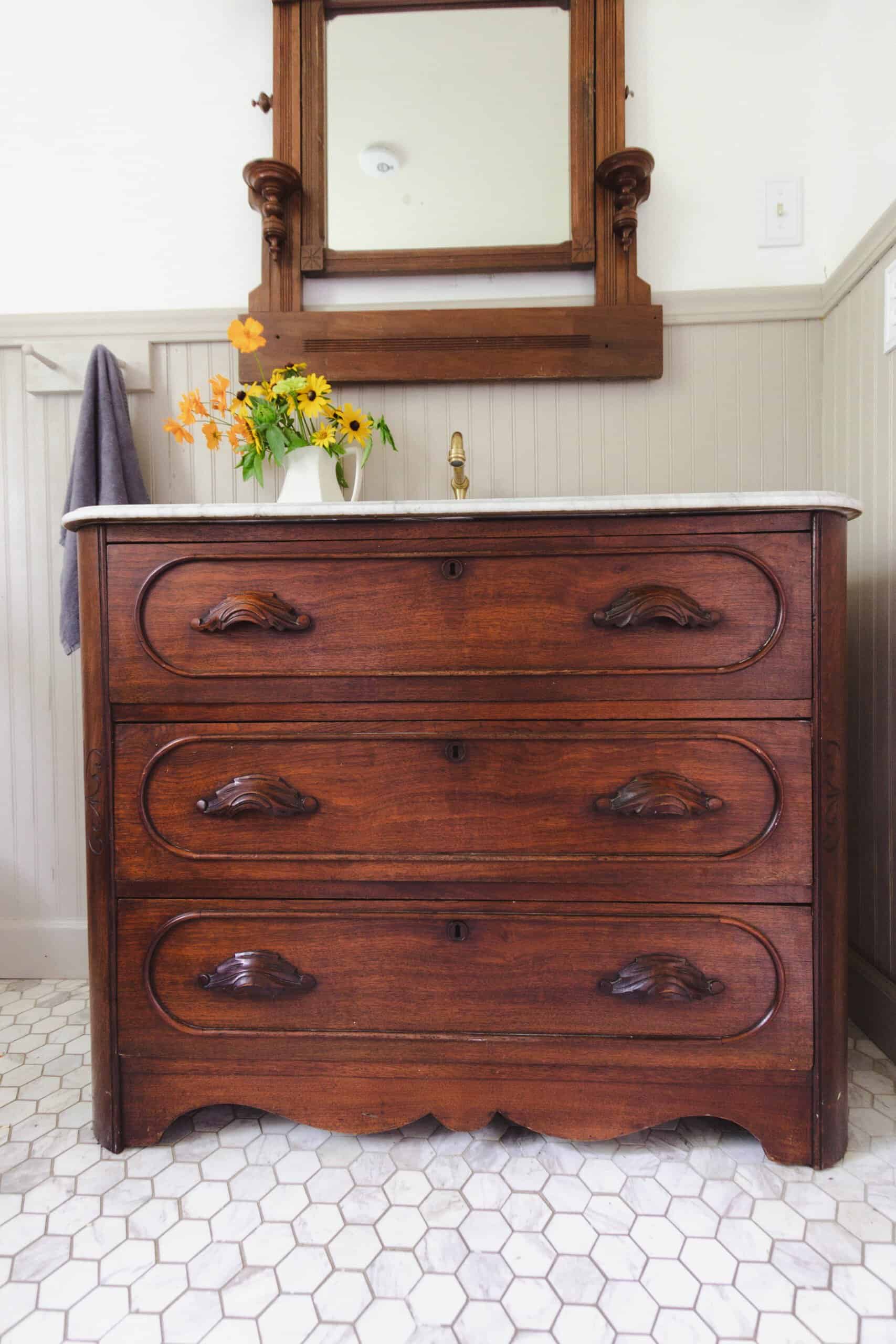
Choosing the Right Antique Dresser for Your Vanity
Selecting the perfect antique dresser to convert into a bathroom vanity is a critical step in the process. It requires a balance of aesthetic appeal, functionality, and structural integrity. Here are several factors to consider when choosing the right antique dresser for your bathroom vanity.
Size and Proportions
The first consideration should be the size and proportions of the dresser. Measure your bathroom space carefully to determine the appropriate size for the vanity. The dresser should be large enough to accommodate a sink and provide storage but not so large that it overwhelms the space. Consider the depth of the dresser as well, ensuring it will fit comfortably within your bathroom’s layout.
Structural Integrity
When selecting an antique dresser, it’s important to ensure that it’s structurally sound. Check for any signs of damage, such as cracks, warping, or loose joints. The dresser must be sturdy enough to support the weight of a sink and withstand daily use. If the dresser needs repairs, factor in the cost and feasibility of making those adjustments.
Material and Finish
Antique dressers come in a variety of materials and finishes, from rich mahogany and oak to delicate veneers and painted surfaces. Choose a material that complements the overall style of your bathroom. Consider how the finish will interact with moisture and humidity, which are common in bathrooms. You may need to refinish the dresser with a waterproof sealant to protect it from damage.
Storage Potential
One of the benefits of using an antique dresser as a vanity is the potential for added storage. Look for a dresser with multiple drawers or compartments that can be repurposed to store bathroom essentials. However, keep in mind that some drawers may need to be modified or removed to accommodate plumbing. Think creatively about how you can maximize storage while maintaining the dresser’s original charm.
Aesthetic Compatibility
The dresser you choose should align with the overall aesthetic of your bathroom. Whether your bathroom has a traditional, modern, or eclectic style, there’s an antique dresser that can fit seamlessly into the design. Pay attention to details such as hardware, carvings, and overall shape, ensuring that they complement other elements in the bathroom.
Budget Considerations
Antique dressers can vary widely in price, depending on factors like age, craftsmanship, and condition. Set a budget before you begin your search, and be realistic about what you can afford. Remember to factor in additional costs such as refinishing, modifications, and installation. With careful planning, you can find a dresser that meets both your aesthetic preferences and budget constraints.
Preparing the Dresser: Restoration and Modifications
Once you’ve chosen the perfect antique dresser, the next step is preparing it for conversion into a bathroom vanity. This process often involves restoration and modifications to ensure the dresser can withstand the unique conditions of a bathroom. Here’s a list of essential steps to consider.
Assessing the Condition
Before you begin any modifications, thoroughly assess the condition of the dresser. Look for signs of wear and tear, such as scratches, dents, or water damage. Determine if the dresser needs repairs or if any parts need to be replaced. This initial assessment will help you plan the restoration process and identify any potential challenges.
Cleaning and Refinishing
Cleaning the dresser is an important step in restoration. Use a gentle cleaner to remove dirt, grime, and old polish. If the dresser has a finish that’s in good condition, a simple clean may suffice. However, if the finish is damaged or worn, consider sanding it down and applying a fresh coat of paint or stain. Opt for a finish that’s resistant to moisture, such as polyurethane, to protect the wood from bathroom humidity.
Modifying for Plumbing
Converting an antique dresser into a bathroom vanity requires modifications to accommodate plumbing. You’ll need to cut holes in the top of the dresser for the sink and faucet, as well as in the back for plumbing connections. Use a hole saw or jigsaw for this task, and take care to measure and mark the placement of the holes accurately. If you’re not confident in your DIY skills, consider hiring a professional to ensure the modifications are done correctly.
Reinforcing the Structure
Depending on the condition and design of the dresser, you may need to reinforce its structure. This is especially important if the dresser is old or delicate. Consider adding additional support to the top surface, such as a plywood base, to provide extra stability for the sink. Reinforce any weak joints or legs to ensure the dresser can handle the weight and daily use as a vanity.
Sealing and Protecting
Bathrooms are exposed to moisture, which can damage wood over time. To protect your antique dresser, apply a sealant to all surfaces, including the inside of drawers and the back panel. A waterproof sealant will help prevent warping, cracking, and mold growth. Ensure that all exposed wood is properly sealed, especially around areas where the sink and faucet will be installed.
Reassembling and Final Touches
After all modifications and restorations are complete, reassemble the dresser and add any final touches. Reattach drawers, replace hardware if needed, and give the dresser a final polish. Check that all modifications have been done correctly and that the dresser is ready for installation as a bathroom vanity. These final touches will ensure your antique dresser is both beautiful and functional in its new role.
Selecting the Perfect Sink and Faucet for Your Vanity
Choosing the right sink and faucet is crucial to the overall functionality and aesthetics of your antique dresser bathroom vanity. These fixtures need to complement the dresser while also fitting within the space and meeting your practical needs. Here’s a guide to help you select the perfect sink and faucet for your vanity.
Sink Style and Size
The style and size of the sink are important considerations when converting an antique dresser into a vanity. The sink should fit comfortably on the dresser’s surface without overwhelming it. Common styles include vessel sinks, which sit on top of the dresser, and undermount sinks, which are installed beneath the countertop. Vessel sinks are popular for antique dressers because they preserve more of the dresser’s surface area and add a touch of elegance.
Material Considerations
Sinks come in a variety of materials, each with its own aesthetic and functional benefits. Ceramic, porcelain, and stone are popular choices for antique dresser vanities. Ceramic and porcelain are easy to clean and maintain, while stone adds a luxurious feel but may require more maintenance. Consider how the sink material will complement the wood and finish of your dresser, as well as how it will hold up in a high-moisture environment.
Faucet Style and Placement
The faucet is another critical element in your vanity setup. Choose a faucet style that complements both the sink and the dresser. Options range from traditional, vintage-inspired designs to sleek, modern styles. The placement of the faucet is also important—consider whether it will be mounted on the sink, the countertop, or the wall behind the dresser. Ensure that the faucet height and reach are compatible with your chosen sink.
Finish and Hardware Coordination
The finish of your faucet should coordinate with other hardware in the bathroom, including the dresser’s drawer pulls and knobs. Popular finishes include chrome, brushed nickel, oil-rubbed bronze, and antique brass. Matching the finish across all hardware elements creates a cohesive look and enhances the overall aesthetic of the bathroom. Consider how the faucet finish will age over time and whether it will require regular maintenance to maintain its appearance.
Functionality and Water Efficiency
While aesthetics are important, don’t overlook functionality when choosing your sink and faucet. Ensure that the faucet is easy to use and provides adequate water flow. Look for water-efficient models that help conserve water without sacrificing performance. Consider features like single-handle operation for ease of use, especially in a busy bathroom environment.
Installation and Compatibility
Finally, consider the installation process and compatibility of your chosen sink and faucet. Ensure that the sink and faucet are compatible with each other and with the modifications made to your dresser. Some sinks may require specific faucet types or placements, so it’s important to check these details before making a purchase. If you’re unsure about installation, consult with a professional plumber to ensure everything is installed correctly and functions as intended.
Incorporating Storage and Functionality in Your Vanity Design
One of the advantages of using an antique dresser as a bathroom vanity is the potential for added storage and functionality. With a few thoughtful modifications, you can create a vanity that not only looks beautiful but also serves as a practical storage solution. Here are some ideas for incorporating storage and functionality into your antique dresser vanity design.
Maximizing Drawer Space
The drawers in your antique dresser can be repurposed for bathroom storage, but some may need to be modified to accommodate plumbing. Consider which drawers can be kept intact and which will need to be adjusted. For those that remain functional, use them to store items like toiletries, towels, and cleaning supplies. Adding dividers or organizers can help keep the contents neat and easily accessible.
Adding Shelving or Cabinets
If your antique dresser has an open space beneath the drawers, consider adding shelving or cabinet doors to create additional storage. Shelves can be used to store baskets, towels, or decorative items, while cabinets provide a concealed space for larger items. Custom cabinetry can be built to match the dresser’s style and finish, ensuring a cohesive look.
Incorporating Hidden Storage
Hidden storage is a clever way to maintain the dresser’s aesthetic while increasing functionality. For example, you can add a false drawer front that conceals the plumbing or create a pull-out tray that slides out from beneath the bottom drawer. These hidden features keep the vanity looking sleek and uncluttered while providing practical storage options.
Utilizing the Countertop
The top surface of the dresser can be used as additional storage space. Consider adding a tray or organizer for small items like soap, toothbrushes, and cosmetics. If you’ve chosen a vessel sink, the surrounding countertop area can be used to display decorative items or store everyday essentials. Just be sure to keep the countertop tidy to maintain the dresser’s elegant appearance.
Incorporating Power Outlets
Adding power outlets to your vanity can greatly enhance its functionality. Consider installing outlets inside a drawer or on the side of the dresser to accommodate items like hairdryers, electric razors, or toothbrush chargers. This keeps cords and devices neatly tucked away when not in use, reducing clutter on the countertop and maintaining the dresser’s clean lines.
Maintaining Balance Between Form and Function
When designing your antique dresser vanity, it’s important to strike a balance between form and function. While storage and functionality are key, they shouldn’t detract from the dresser’s aesthetic appeal. Be mindful of the dresser’s original design and try to maintain its character as much as possible. Thoughtful modifications and additions can enhance both the beauty and practicality of your vanity, creating a bathroom fixture that is as functional as it is stunning.
Styling and Decorating Around Your Antique Vanity
Once your antique dresser bathroom vanity is installed, it’s time to think about styling and decorating the space around it. The vanity will likely serve as a focal point, so it’s important to choose decor that complements its vintage charm while enhancing the overall aesthetic of your bathroom. Here are some tips for styling and decorating around your antique vanity.
Choosing the Right Mirror
The mirror above your vanity plays a significant role in the overall look of your bathroom. Consider selecting a mirror that complements the style of your antique dresser. Ornate, vintage-inspired frames work well with antique vanities, adding to the old-world charm. Alternatively, a simple, frameless mirror can provide a modern contrast, allowing the dresser to take center stage. Ensure that the size and proportion of the mirror align with the vanity for a balanced look.
Selecting Lighting Fixtures
Lighting is crucial in both functionality and style. Choose lighting fixtures that enhance the antique vanity’s aesthetic while providing adequate illumination. Wall sconces on either side of the mirror can create a classic, symmetrical look, while a statement chandelier adds a touch of luxury. Opt for fixtures in finishes that coordinate with the hardware on your vanity, such as brass, bronze, or nickel, to create a cohesive design.
Incorporating Vintage Accessories
To reinforce the vintage theme, consider incorporating vintage accessories into your bathroom decor. Items like antique perfume bottles, decorative trays, and old-fashioned soap dishes can enhance the overall look. Be mindful of not overcrowding the space—select a few key pieces that complement the vanity without overwhelming it. These accessories add a personal touch and help tie the room together.
Using Textiles to Add Warmth
Soft textiles can add warmth and comfort to your bathroom, making it feel more inviting. Consider adding plush towels, a vintage-style rug, or a fabric shower curtain that complements the color scheme of your vanity. Textiles can introduce color, pattern, and texture, balancing the hard surfaces in the bathroom and creating a cozy, layered look.
Adding Greenery and Natural Elements
Plants and natural elements bring life to any space, and the bathroom is no exception. Consider adding potted plants, such as ferns or succulents, to your bathroom vanity or windowsill. The greenery contrasts beautifully with the wood of the dresser and adds a refreshing, organic feel to the room. If space allows, consider incorporating other natural elements like stone or wood accessories to further enhance the earthy, vintage vibe.
Creating a Cohesive Color Scheme
Finally, consider the color scheme of your bathroom and how it complements the antique vanity. Neutral tones like whites, creams, and grays work well with most antique dressers, allowing the wood’s natural beauty to shine. If you prefer more color, consider soft pastels or rich jewel tones that enhance the dresser’s finish. The key is to create a cohesive color palette that ties together all elements in the room, from the vanity to the walls, tiles, and accessories.
Maintaining and Caring for Your Antique Dresser Bathroom Vanity
Your antique dresser bathroom vanity is a beautiful and unique addition to your home, but it requires proper care and maintenance to keep it looking its best. Antique furniture can be sensitive to moisture and wear, so it’s important to take steps to protect it. Here’s a guide on how to maintain and care for your antique dresser bathroom vanity.
Protecting Against Moisture
Bathrooms are humid environments, and moisture is the biggest threat to wooden furniture. To protect your antique dresser, ensure that it is properly sealed with a waterproof finish. This includes all surfaces, including the top, sides, and interior of drawers. Regularly check the sealant for any signs of wear and reapply as needed to maintain its protective barrier.
Cleaning and Polishing
Regular cleaning is essential to keep your antique dresser looking beautiful. Use a soft, damp cloth to wipe down the surface, followed by a dry cloth to remove any remaining moisture. Avoid using harsh chemicals or abrasive cleaners, as they can damage the wood and finish. Periodically, apply a high-quality furniture polish to nourish the wood and maintain its luster.
Preventing Scratches and Damage
Antique furniture can be prone to scratches and dents, especially in a high-traffic area like a bathroom. To prevent damage, be mindful of placing heavy or sharp objects directly on the dresser’s surface. Use coasters or mats under items like soap dispensers, and consider placing a protective mat under the sink area to catch any drips or spills. Additionally, be careful when opening and closing drawers to avoid unnecessary wear.
Managing Temperature and Humidity
Extreme temperature changes and high humidity levels can cause wood to expand, contract, or warp. To protect your antique dresser, try to maintain a consistent temperature and humidity level in your bathroom. Use a dehumidifier if necessary to reduce moisture levels, and avoid placing the dresser near heating vents or direct sunlight, which can cause the wood to dry out and crack.
Repairing and Refinishing
Over time, your antique dresser may require repairs or refinishing to maintain its beauty and functionality. Small scratches and dings can often be repaired with touch-up markers or wood filler, while more significant damage may require professional restoration. If the finish becomes worn or damaged, consider refinishing the dresser with a fresh coat of paint or stain, ensuring that the new finish is moisture-resistant.
Regular Inspections
Regularly inspecting your antique dresser vanity is key to catching any potential issues before they become major problems. Check for signs of moisture damage, such as warping, discoloration, or mold. Also, inspect the hardware and joints to ensure they remain secure. Addressing any issues promptly will help extend the life of your antique dresser and keep it looking beautiful for years to come.
Common Mistakes to Avoid
Overlooking Structural Integrity
One of the biggest mistakes is not thoroughly assessing the structural integrity of the antique dresser before converting it into a vanity. Weak joints or damaged wood can lead to problems down the line. Always ensure the dresser is sturdy enough to handle the modifications and daily use.
Skipping the Sealing Process
Failing to properly seal the dresser can result in moisture damage. Bathrooms are humid environments, and wood furniture is susceptible to warping and mold. Always apply a waterproof sealant to protect the dresser from moisture.
Improper Plumbing Modifications
Modifying the dresser for plumbing requires precision. Cutting holes in the wrong place or making them too large can compromise the dresser’s integrity. If you’re unsure about this step, it’s best to consult a professional.
Choosing Incompatible Fixtures
Selecting a sink or faucet that doesn’t fit well with the dresser can lead to aesthetic and functional issues. Always ensure that the fixtures you choose are compatible with the dresser’s size and style.
Neglecting Regular Maintenance
Antique furniture requires regular care to maintain its appearance and functionality. Neglecting cleaning, polishing, and inspections can lead to damage over time. Set a routine for maintaining your dresser to ensure its longevity.
Ignoring the Overall Bathroom Design
Focusing solely on the dresser without considering the overall bathroom design can result in a mismatched look. Ensure that the dresser vanity complements the rest of the bathroom’s decor, including the mirror, lighting, and accessories.
Can any antique dresser be converted into a bathroom vanity?
Not all antique dressers are suitable for conversion into a bathroom vanity. It’s important to choose a dresser that is structurally sound and the right size for your bathroom. Additionally, the dresser should be made of a material that can withstand moisture, such as solid wood.
How do I protect the wood from moisture in the bathroom?
To protect the wood from moisture, apply a waterproof sealant to all surfaces of the dresser. Regularly inspect the sealant and reapply as needed. Additionally, ensure proper ventilation in your bathroom to reduce humidity levels.
Is it difficult to modify an antique dresser for plumbing?
Modifying an antique dresser for plumbing can be challenging, especially if you’re not experienced with woodworking. It involves cutting holes for the sink and faucet, as well as making space for plumbing connections. If you’re unsure, it’s advisable to consult a professional.
What type of sink is best for an antique dresser vanity?
Vessel sinks are a popular choice for antique dresser vanities because they sit on top of the dresser, preserving more of the surface area. However, undermount sinks can also work well, depending on the dresser’s design. Choose a sink that fits well with the dresser’s size and style.
Can I install a countertop on an antique dresser vanity?
Yes, you can install a countertop on an antique dresser vanity. Popular options include stone, marble, or a custom wood countertop. The countertop should be cut to fit the dresser and should complement the overall design of the bathroom.
How do I maintain the finish on my antique dresser vanity?
To maintain the finish on your antique dresser vanity, regularly clean it with a soft, damp cloth and apply furniture polish to nourish the wood. Avoid using harsh chemicals or abrasive cleaners. Additionally, protect the surface from scratches by using coasters or mats under bathroom items.
Vintage Dresser Bathroom Vanity – Lovely Etc.
BATHROOM VANITY ANTIQUE Rustic From Antique Dresser
Related Posts:
- Homemade Bathroom Vanity Ideas
- Fresca Bathroom Vanity
- Bathroom Vanity With Matching Mirror
- Bathroom Vanity Tops 43 X 22
- Bathroom Vanity 42 Inches Wide
- What Size Light Fixture Over Bathroom Vanity
- Bathroom Vanity Light Replacement Parts
- Bathroom Vanity With Upper Cabinets
- French Style Bathroom Vanity
- Bathroom Vanity Stools With Wheels
